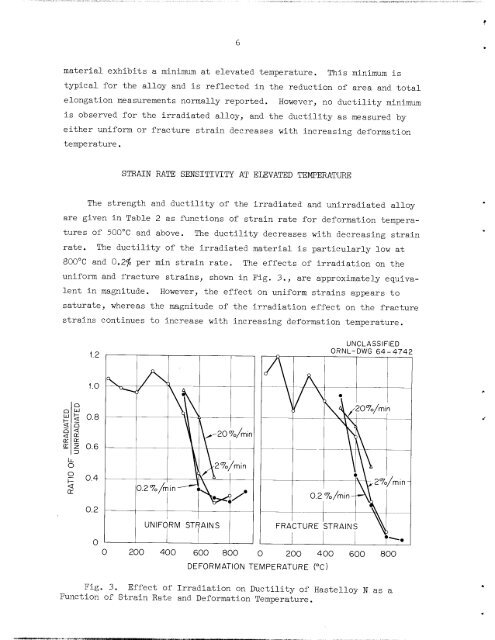Effect of Elevated Temperature Irradiation on the Strength and ...
Effect of Elevated Temperature Irradiation on the Strength and ...
Effect of Elevated Temperature Irradiation on the Strength and ...
Create successful ePaper yourself
Turn your PDF publications into a flip-book with our unique Google optimized e-Paper software.
material exhibits a minimum at elevated temperature. This minimum is<br />
typical for <strong>the</strong> alloy <strong>and</strong> is reflected in <strong>the</strong> reducti<strong>on</strong> <str<strong>on</strong>g>of</str<strong>on</strong>g> area <strong>and</strong> total<br />
el<strong>on</strong>gati<strong>on</strong> measurements normally reported. However, no ductility minimum<br />
is observed for <strong>the</strong> irradiated alloy, <strong>and</strong> <strong>the</strong> ductility as measured by<br />
ei<strong>the</strong>r uniform or fracture strain decreases with increasing deformati<strong>on</strong><br />
temperature.<br />
STRAIN RATE SENSITIVITY AT ELEVATED TEMPERATURE<br />
The strength <strong>and</strong> ductility <str<strong>on</strong>g>of</str<strong>on</strong>g> <strong>the</strong> irradiated <strong>and</strong> unirradiated alloy<br />
are given in Table 2 as functi<strong>on</strong>s <str<strong>on</strong>g>of</str<strong>on</strong>g> strain rate for deformati<strong>on</strong> tempera<br />
tures <str<strong>on</strong>g>of</str<strong>on</strong>g> 500°C <strong>and</strong> above. The ductility decreases with decreasing strain<br />
rate. The ductility <str<strong>on</strong>g>of</str<strong>on</strong>g> <strong>the</strong> irradiated material is particularly low at<br />
800°C <strong>and</strong> 0.2$ per min strain rate. The effects <str<strong>on</strong>g>of</str<strong>on</strong>g> irradiati<strong>on</strong> <strong>on</strong> <strong>the</strong><br />
uniform <strong>and</strong> fracture strains, shown in Fig. 3., are approximately equiva<br />
lent in magnitude. However, <strong>the</strong> effect <strong>on</strong> uniform strains appears to<br />
saturate, whereas <strong>the</strong> magnitude <str<strong>on</strong>g>of</str<strong>on</strong>g> <strong>the</strong> irradiati<strong>on</strong> effect <strong>on</strong> <strong>the</strong> fracture<br />
strains c<strong>on</strong>tinues to increase with increasing deformati<strong>on</strong> temperature.<br />
Ll<br />
O<br />
O<br />
<<br />
or<br />
UNCLASSIFIED<br />
ORNL-DWG 64-4742<br />
0 200 400 600 800 0 200 400 600 800<br />
DEFORMATION TEMPERATURE (°C)<br />
Fig. 3. <str<strong>on</strong>g>Effect</str<strong>on</strong>g> <str<strong>on</strong>g>of</str<strong>on</strong>g> <str<strong>on</strong>g>Irradiati<strong>on</strong></str<strong>on</strong>g> <strong>on</strong> Ductility <str<strong>on</strong>g>of</str<strong>on</strong>g> Hastelloy N as a<br />
Functi<strong>on</strong> <str<strong>on</strong>g>of</str<strong>on</strong>g> Strain Rate <strong>and</strong> Deformati<strong>on</strong> <str<strong>on</strong>g>Temperature</str<strong>on</strong>g>.

















